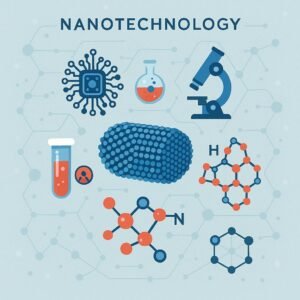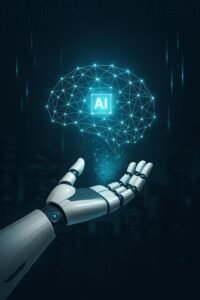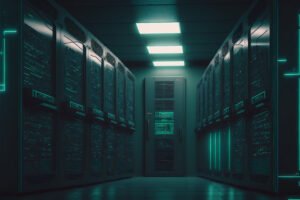Revised Introduction and Combined Blog Post: UPSC Prelims Nanotechnology: 37-Day Revision & AI
Introduction
With the UPSC Prelims exam just 37 days away, strategic and focused revision is key. This guide is your fast-track to mastering Nanotechnology and its crucial applications, a vital topic for the UPSC Prelims. We’ll provide a concise 37-day revision strategy for UPSC Prelims Nanotechnology, covering essential concepts like nanomaterials, nano fertilizers, and the latest advancements. Furthermore, given its increasing relevance, we’ll also touch upon related concepts in Artificial Intelligence (AI), including deepfakes and supercomputers, to give you a well-rounded preparation.
1. Nanotechnology – An In-Depth Overview for UPSC
About
This post provides an in-depth introduction to nanotechnology, covering its core concepts, the unique properties of nanomaterials, their classification, and diverse applications.
Key Points
-
Nanotechnology involves the manipulation of materials and the engineering of devices at the nanoscale, with sizes typically ranging from 1 to 100 nanometers (nm).
-
Materials at the nanometer scale exhibit unusual properties that are highly dependent on their shape, size, surface characteristics, and internal structure.
-
Nanomaterials can be categorized into two types:
Natural nanomaterials, such as volcanic ash.
Artificial nanomaterials, such as carbon nanotubes.
-
-
A significant concern associated with nanotechnology is the potential toxicity of nanoparticles to both humans and the environment.
-
Nanotechnology has a wide array of key applications across various sectors:
- Agriculture: Nano fertilizers enhance nutrient uptake efficiency (90-100% utilization), and nanobiosensors monitor soil conditions.
- Health: Nanotechnology enables better imaging and diagnostics, as well as targeted drug delivery systems.
- Energy: Nanostructured solar cells offer the potential for cheaper manufacturing and easier installation.
- Environment: Nanomaterials are utilized in water purification and desalination technologies.
- Electronics and IT: Quantum dots and other nanostructures are employed in the development of advanced displays and lighting.
- Other applications include the use of nanoparticles of certain metallic oxides in cosmetics.

Impact
- Nanotechnology holds the potential to revolutionize various fields by offering solutions for:
- Improving agricultural practices through enhanced nutrient delivery and soil monitoring.
- Advancing healthcare with more precise diagnostics and targeted therapies.
- Developing sustainable energy solutions with more efficient solar cells.
- Providing innovative approaches to environmental challenges like water purification.
- Driving progress in electronics and IT with advanced materials for displays and lighting.
Challenges and Way Forward
-
A primary challenge is thoroughly investigating and mitigating the potential toxicity of nanoparticles to ensure the safety of both humans and the environment.
-
Continued research and development are essential to fully harness the benefits of nanotechnology and address its associated challenges.
-
The establishment of robust safety regulations and ethical guidelines is crucial for the responsible advancement and implementation of nanotechnology.
2.Nano Fertilizers
About
This post discusses nano fertilizers and their approval for use.
Key Points
-
Indian Farmers Fertiliser Cooperative Limited (IFFCO) received approval under the Fertiliser (Control) Order, 1985 (FCO) for Nano Zinc and Nano Copper liquids.
-
Nano fertilizers are nutrients encapsulated within a nanomaterial to enable controlled release and slow diffusion into the soil.
-
Nano Zinc and Nano Copper liquids help address the deficiency of micronutrients.
Zinc is important for enzyme functioning, plant growth, and development.
Copper is important for enzymatic activities, chlorophyll, and seed production in plants.
-
IFFCO previously received approval for its nano-liquid urea and nano-liquid Di-Ammonia Phosphate (DAP).
-
The Mission on Nano Science and Technology (Nano Mission), 2007, under the Department of Science & Technology (DST) is another government initiative related to nanotechnology in agriculture.
Recent Developments
Recent FCO approvals for Nano Zinc and Nano Copper liquids by IFFCO.
Impact
-
Nano fertilizers offer controlled release and slow diffusion of nutrients, potentially increasing nutrient utilization efficiency.
-
Nano Zinc and Nano Copper liquids can help correct micronutrient deficiencies in crops.
Challenges and Way Forward
-
Further research is needed to assess the long-term impact of nano fertilizers on soil health and the environment.
-
Ensuring the safe and effective application of nano fertilizers in agriculture is crucial.
3.Artificial Intelligence (AI) and Related Terms
About
This post defines Artificial Intelligence (AI) and explains related concepts like Generative AI, Large Language Models (LLMs), and Machine Learning.
Key Points
-
Artificial Intelligence (AI) is a technology that enables computers and machines to simulate human learning, comprehension, problem-solving, decision-making, creativity, and autonomy.
-
AI can be categorized into stages:
- Artificial Narrow Intelligence (ANI): Machines imitate human behavior, specializing in one area to solve a problem (e.g., Siri, ChatGPT, Alexa).
- Artificial General Intelligence (AGI): Machines can continuously learn and are as smart as humans.
- Artificial Super Intelligence (ASI): Machines that are smarter than humans across the board.
-
Generative AI is AI that can create original content, such as text, images, video, audio, or software code.

Artificial Intelligence -
Generative AI tools are built on AI models like Large Language Models (LLMs) and rely on deep learning models, which are algorithms that simulate the learning and decision-making processes of the human brain.
-
Traditional AI analyzes data, performs specific tasks, and automates decision-making, while Generative AI creates new data.
-
Traditional AI relies on explicit rules and algorithms and produces structured outputs, whereas Generative AI uses data-driven learning (neural networks) to generate entirely new content or creative outputs.
-
Traditional AI requires manual intervention and reprogramming to adapt, but Generative AI can automatically adjust and improve its performance over time.
-
Large Language Models (LLMs) are a category of foundation models (large AI models) capable of understanding and generating natural language and other types of content to perform a wide range of tasks.
-
LLMs work by learning patterns from vast amounts of data and interpreting human language.
-
LLMs are typically based on transformer architecture and consist of multiple layers of neural networks and self-attention mechanisms that enable them to learn patterns.
-
Machine Learning (ML) is a component of AI that enables AI to imitate the way humans learn, gradually improving its accuracy.
-
ML works by training algorithms on sets of data to achieve an expected outcome, such as identifying a pattern or recognizing an object.
-
Neural Networks or Artificial Neural Networks (ANNs) are a specific class of ML algorithms commonly used.
-
Large Action Models (LAMs) are AI models that can understand and execute complex tasks by translating human intentions into action.
-
AI agents can engage in real-time, multi-modal (text, image, or voice) interactions with humans and perceive their environment via sensors.
Recent Developments
- The field of AI is rapidly evolving, with ongoing advancements in Generative AI, LLMs, Machine Learning, and AI agents.
Impact
- AI has the potential to transform various industries and aspects of life by automating tasks, enhancing decision-making, and enabling the creation of new forms of content and interaction.
Challenges and Way Forward
- Addressing ethical concerns, ensuring responsible development and deployment, and mitigating potential risks are crucial challenges in the field of AI.
4: Nobel Prize in Physics 2024 (Artificial Neural Networks (ANNs))
About
This post discusses the 2024 Nobel Prize in Physics, awarded for foundational discoveries in Artificial Neural Networks (ANNs) and Machine Learning (ML).
Key Points
-
The 2024 Nobel Prize in Physics was awarded to John J. Hopfield and Geoffrey Hinton.
-
The prize recognizes their foundational discoveries and inventions that enabled Machine Learning (ML) with Artificial Neural Networks (ANNs).
-
John Hopfield invented the Hopfield network, a type of recurrent neural network capable of storing and reconstructing information.
-
The Hopfield network functions as a memory system, storing and retrieving patterns.
-
This network’s operation is based on Donald Hebb’s hypothesis, which posits that simultaneous neuron activity enhances the network’s ability to process and store information.
-
Geoffrey Hinton invented the Boltzmann machine, a method that allows AI to independently discover properties within data.
-
Artificial Neural Networks (ANNs) are Machine Learning models that make decisions similar to the human brain by mimicking the way biological neurons work together.
-
ANNs that closely mimic natural neural networks are known as Spiking Neural Networks (SNNs).
-
Major types of ANNs include:
Deep Neural Networks: Networks with many layers.
Convolutional Neural Networks (CNNs): Used for image and video analysis.
Generative Adversarial Networks (GANs): Used to create new data.
-
The brain’s neural network is built from living cells (neurons) that communicate through synapses.
-
Artificial Neural Networks are built from nodes that are coded with a value and connected to each other.
-
Learning in the brain involves strengthening or weakening connections between neurons.
-
Similarly, in ANNs, the connections between nodes that are active at the same time get stronger, while others get weaker.
Timeline
-
1949: Donald Hebb’s hypothesis.
-
2024: Nobel Prize in Physics awarded to John J. Hopfield and Geoffrey Hinton.
Recent Developments
- Ongoing research and development continue to advance the capabilities of Artificial Neural Networks and Machine Learning.
Impact
- The discoveries recognized by the Nobel Prize have laid the foundation for modern AI applications, driving advancements in fields like image recognition, natural language processing, and more.
Challenges and Way Forward
-
Continued research is focused on improving the efficiency, interpretability, and robustness of Artificial Neural Networks.
-
Addressing ethical considerations and potential societal impacts remains a crucial challenge.
5: BharatGen Programme
About
This post discusses the BharatGen Programme, a Generative AI initiative in India.
Key Points
-
The Ministry of Science and Technology launched BharatGen, a Generative Artificial Intelligence (AI) initiative.
-
BharatGen is a Multimodal Large Language Model (LLM) project focused on creating Generative AI systems that can generate high-quality text and multimodal content (audio and imagery) in various Indian languages.
-
The program aims to revolutionize public service delivery and boost citizen engagement by crafting a path tailored to India’s diverse linguistic, cultural, and societal fabric.
-
The implementing agency is the TIH Foundation for IoT & IoE (TIH-IoT) under the National Mission on Interdisciplinary Cyber-Physical Systems (NM-ICPS).
-
The project is expected to be completed in two years (by July 2026).
-
Bharat Data Sagar aims to establish a vast repository of India-centric data to ensure that the AI models are deeply rooted in the country’s unique context.
Timeline
-
2018: Approval of the National Mission on Interdisciplinary Cyber Physical Systems (NM-ICPS).
-
2026 (Expected): Completion of the BharatGen Programme.
Recent Developments
- Launch of the BharatGen Programme by the Ministry of Science and Technology.
Challenges and Way Forward
-
Developing AI models that accurately and effectively capture the nuances of India’s diverse linguistic and cultural landscape is a key challenge.
-
Building a comprehensive and representative India-centric data repository (Bharat Data Sagar) is crucial for the success of the program.
6.Facial Recognition Technology (FRT)
About
This post discusses Facial Recognition Technology (FRT) and its applications.
Key Points
-
Facial Recognition Technology (FRT) is an AI system that identifies or verifies a person using images or video data and complex algorithms.
-
FRT has two main purposes:
- 1:1 verification of identity: Matching a facial map against a person’s photograph in a database (e.g., unlocking phones).
- 1:n identification of identity: Verification against an entire database to identify a person in a photograph or video (e.g., mass monitoring and surveillance).
Key applications of FRT:
- Security: Law enforcement (identifying persons of interest or missing persons), crowd control.
-
- Non-security: Verification and authentication for access to products/services (e.g., Aadhaar-based authentication), contactless onboarding at airports (Digi Yatra), enhanced banking security.
Recent Developments
-
NITI Aayog released a white paper on “Responsible AI for All (RAI)” focusing on Facial Recognition Technology.
-
FRT is being implemented in various sectors to enhance security and convenience.
7.Deepfakes
About
This post discusses deepfakes and measures to counter them.
Key Points
-
Deepfakes are synthetic media, typically images and videos, created using AI and deep learning techniques.
-
Deepfakes differ from shallowfakes, which use conventional technologies to create altered media.
-
Deepfakes utilize Generative Adversarial Networks (GANs) to analyze and synthesize audio and visual content.
-
Applications of deepfakes include natural and accurate dubbing in movies and TV shows and training simulations.
-
Measures to counter deepfakes:
- Section 66D of the Information Technology (IT) Act, 2000, provides punishment for cheating by impersonation using any communication device.
- Rules 3(1)(b) and Rule 3(2)(b) of the Information Technology (Intermediary Guidelines and Digital Media Ethics Code) Rules, 2021, mandate social media intermediaries to observe due diligence to not host obscene content that deceives or misleads.
Recent Developments
- The Election Commission of India has cautioned parties against using AI-based tools to create deepfakes that distort information or spread misinformation.
Impact
- Deepfakes have the potential to be used for both beneficial purposes (e.g., entertainment, training) and malicious purposes (e.g., spreading misinformation, defamation).
Challenges and Way Forward
-
Detecting and mitigating the harmful effects of deepfakes is a significant challenge.
-
Developing technological and legal safeguards is crucial to prevent the misuse of deepfakes
8: S.A.R.A.H.
About
This post discusses S.A.R.A.H., a digital health promoter prototype.
Key Points
- WHO unveiled a digital health promoter prototype named S.A.R.A.H. that utilizes Generative AI for public health.
S.A.R.A.H. provides information on various health topics, including healthy habits and mental health.
- It supports the development of a better understanding of risk factors associated with major causes of death, such as cancer, heart disease, lung disease, and diabetes.
- WHO’s unveiling of the S.A.R.A.H. digital health promoter prototype.
9: Extended Reality (XR)
About
This post explains Extended Reality (XR) and its related technologies.
Key Points
-
Extended Reality (XR) is an umbrella term that encompasses Augmented Reality (AR), Virtual Reality (VR), and Mixed Reality (MR)
-
Augmented Reality (AR) involves the real-time integration of digital information into a user’s real-world environment.
-
AR devices use cameras, sensors, and displays to capture the physical world and integrate digital content, projecting computer-generated images onto real-life objects.
-
Virtual Reality (VR) creates a simulated environment, completely shutting out the physical world.
-
Mixed Reality (MR) is a hybrid technology that combines AR and VR to provide an interactive virtual experience within the real world.
Impact
- XR has the potential to transform how we interact with digital information and the real world, offering immersive and interactive experiences.
Challenges and Way Forward
-
Developing user-friendly and affordable XR devices is an ongoing challenge.
-
Addressing potential concerns related to privacy, accessibility, and the impact of XR on social interaction is important.
11: Supercomputers
About
This post discusses supercomputers and the National Supercomputing Mission (NSM).
Key Points

-
A supercomputer is a high-performance computing system with significantly greater processing power and computational capacity than a general-purpose computer.
-
Supercomputer performance is measured in floating-point operations per second (FLOPS).
-
India’s first supercomputer was PARAM 8000.
-
India’s largest and fastest AI supercomputer, AIRAWAT, was ranked 75th in the Top 500 Global Supercomputing List of 2023.
-
The world’s fastest supercomputer is Frontier (USA), capable of more than a quintillion operations per second (Exaflop).
-
The National Supercomputing Mission (NSM) was launched in 2015 with the objective of making India one of the world leaders in supercomputing.
-
NSM is jointly steered by the Department of Science and Technology (DST) and MeitY.
-
The implementing agencies for NSM are the Centre for Development of Advanced Computing (C-DAC) and the Indian Institute of Science (IISc), Bengaluru.
-
NSM envisages:
Installing a network of supercomputers with a cumulative capacity of 45 PetaFlops.
- Connecting these supercomputers on the National Supercomputing grid over the National Knowledge Network.
-
Key applications of supercomputers:
- Cutting-edge research (e.g., Param Pravega for scientific and engineering purposes).
- Governance (e.g., use of the AIRAWAT system for the Digital India BHASHINI program).
- Health and Medicine (e.g., screening of small molecules against various cancer-specific receptors).
- Disaster Management (e.g., studying the frequency of extreme rainfall).
- Other areas: Weather forecasting, Defense and military, etc.
Timeline
- 2015: Launch of the National Supercomputing Mission (NSM).
Recent Developments
-
The Prime Minister of India virtually launched three Param Rudra Super Computing Systems and a High-Performance Computing (HPC) system for weather and climate research.
-
The new HPC systems, named ‘Arka’ and ‘Arunika,’ will enhance the accuracy of predictions related to tropical cyclones, heavy precipitation, thunderstorms, etc.
Impact
- Supercomputers enable advancements in various fields, including scientific research, governance, healthcare, and disaster management.
Challenges and Way Forward
-
Continued investment in supercomputing infrastructure and research is crucial for India to remain a leader in this field.
-
Developing skilled personnel to operate and utilize supercomputers effectively is essential.